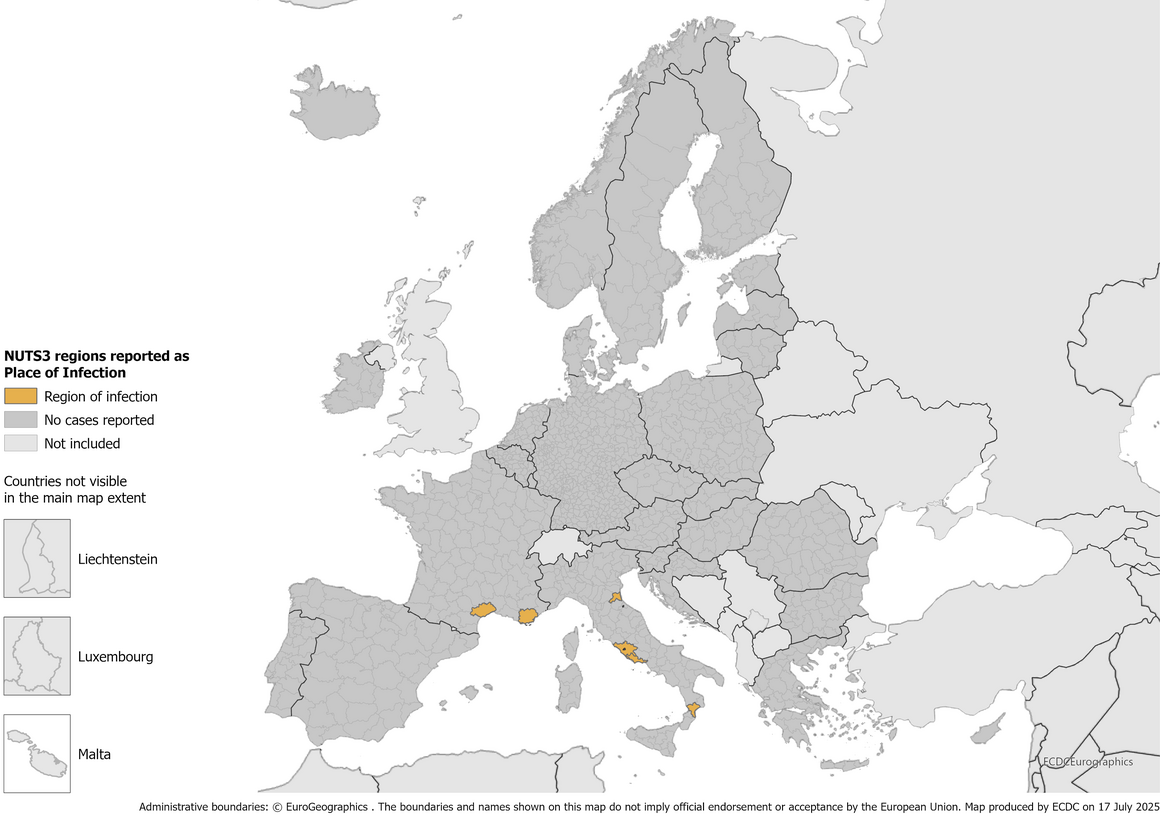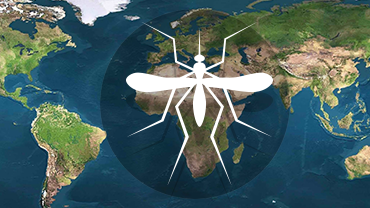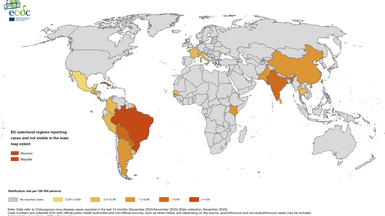Historical data on local transmission in the EU/EEA of chikungunya virus disease
Chikungunya virus disease is an Aedes-borne disease widely distributed in tropical and subtropical regions. Globally, the virus is predominantly transmitted by Ae. aegypti and Ae. albopictus mosquitoes. Aedes albopictus is established in a large part of Europe. Aedes aegypti is established notably in Cyprus, around the Black sea and in the outermost region (OR) of Madeira.
Chikungunya is not endemic in mainland EU/EEA and the majority of the cases are travellers infected outside of mainland EU/EEA. See the risk assessment on chikungunya virus disease for mainland EU/EE.
The table and map below illustrate the chikungunya situation in mainland EU/EEA, excluding the EU ORs. Historically, chikungunya outbreaks have occurred in the French ORs (i.e. French Guiana, Guadeloupe, Réunion, Martinique, Mayotte and Saint-Martin). For the other ORs (Madeira, the Azores, the Canary Islands), no chikungunya virus disease cases were reported.
| Year | Country, region, municipalities | Number of autochthonous cases | Period of circulation (probable) | Origin of the primary travel- related case (probable) | Virus | Presence El- A226V | Reference | |
|---|---|---|---|---|---|---|---|---|
| 2007 | Italy, region of Emilia Romagna, (main transmission areas In Castiglione di Cervia and Castiglione di Ravenna) | 330 suspected, probable and confirmed | July-September | India | CHIKV ECSA | Yes | [1,2] | |
| 2010 | France, Var department, Fréjus | 2 | September | India | CHIKV ECSA | No | [3,4] | |
| 2014 | France, Hérault department, Montpellier | 12 | September- October | Cameroon | CHIKV ECSA | Yes | [5,6] | |
| 2017 | France, Var department, Le Cannet-des- Maures and Taradeau | 17 (1 1 in Cannet des-Maures and 6 in Taradeau) | July- September | Central Africa | CHIKV ECSA | Yes | [5,7,8] | |
| 2017 | Italy, Lazio region (Anzio, Latina and Roma) and Calabria region (Guardavalle marina) | 270 confirmed and 229 probable | August— November | Asia (India/Pakistan) | CHIKV ECSA belonging to a branch of Indian Ocean Lineage (IOL) reported from Indian subcontinent (India, Pakistan) | No | [9-12] | |
| 2024 | France, Ile-de-France, Paris / Hauts-de-Seine, Paris or Gennevilliers | 1 | July | Unknown | Unknown | Unknown | [13] | |
CHIKV ECSA: Chikungunya virus East/Central/South African lineage.
E1-A226V: CHIKV envelope protein 1 with alanine to valine substitution at position 226.
The table combines information published in official reports and in the scientific literature plus information that was provided by the public health institutes and/or the ministries of health in the affected Member States.
Local transmission of chikungunya virus in mainland EU/EEA, 2007–2024

References:
- Angelini R, Finarelli AC, Angelini P, Po C, Petropulacos K, Silvi G, et al. Chikungunya in north-eastern Italy: a summing up of the outbreak. Euro Surveill. 2007 Nov 22;12(11):E071122 2. Available at: https://www.ncbi.nlm.nih.gov/pubmed/18053561
- Rezza G, Nicoletti L, Angelini R, Romi R, Finarelli AC, Panning M, et al. Infection with chikungunya virus in Italy: an outbreak in a temperate region. Lancet. 2007 Dec 1;370(9602):1840-6. Available at: https://www.ncbi.nlm.nih.gov/pubmed/18061059
- Grandadam M, Caro V, Plumet S, Thiberge JM, Souares Y, Failloux AB, et al. Chikungunya virus, southeastern France. Emerg Infect Dis. 2011 May;17(5):910-3. Available at: https://www.ncbi.nlm.nih.gov/pubmed/21529410
- Vega-Rua A, Zouache K, Caro V, Diancourt L, Delaunay P, Grandadam M, et al. High efficiency of temperate Aedes albopictus to transmit chikungunya and dengue viruses in the Southeast of France. PLoS One. 2013;8(3):e59716. Available at: https://www.ncbi.nlm.nih.gov/pubmed/23527259
- Florian Franke SG, Amandine Cochet, Charles Jeannin, Isabelle Leparc-Goffart, Henriette de Valk, Gilda Grard, Mathilde Galla, Frédéric Jourdain, Pascal Chaud, Grégory L’Ambert, Jean-Baptiste Ferré, Xavier de Lamballerie, Marie-Claire Paty,. Émergences de dengue et de chikungunya en France Métropolitaine, 2010-2018 [in French: Autochthonous chikungunya and dengue fever outbreak in mainland France 2010-2018]. Bulletin Epidémiologique Hebdomadaire. 2019;19-20:374-82. Available at: https://www.santepubliquefrance.fr/maladies-et-traumatismes/maladies-a-transmission-vectorielle/chikungunya/documents/article/emergences-de-dengue-et-de-chikungunya-en-france-metropolitaine-2010-2018
- Delisle E, Rousseau C, Broche B, Leparc-Goffart I, L'Ambert G, Cochet A, et al. Chikungunya outbreak in Montpellier, France, September to October 2014. Euro Surveill. 2015 Apr 30;20(17) Available at: https://www.ncbi.nlm.nih.gov/pubmed/25955774
- Calba C, Guerbois-Galla M, Franke F, Jeannin C, Auzet-Caillaud M, Grard G, et al. Preliminary report of an autochthonous chikungunya outbreak in France, July to September 2017. Euro Surveill. 2017 Sep;22(39) Available at: https://www.ncbi.nlm.nih.gov/pubmed/29019313
- Calba C, Guerbois-Galla M, Franke F, Jeannin C, Auzet-Caillaud M, Grard G, et al. Investigation of an autochthonous chikungunya outbreak, July–September 2017, France. Revue d'Épidémiologie et de Santé Publique. 2018 2018/07/01/;66:S387-S8. Available at: https://www.sciencedirect.com/science/article/pii/S0398762018311106
- Venturi G, Di Luca M, Fortuna C, Remoli ME, Riccardo F, Severini F, et al. Detection of a chikungunya outbreak in Central Italy, August to September 2017. Euro Surveill. 2017 Sep;22(39)
- Lindh E, Argentini C, Remoli ME, Fortuna C, Faggioni G, Benedetti E, et al. The Italian 2017 Outbreak Chikungunya Virus Belongs to an Emerging Aedes albopictus-Adapted Virus Cluster Introduced From the Indian Subcontinent. Open Forum Infect Dis. 2019 Jan;6(1):ofy321.
- Riccardo F, Venturi G, Di Luca M, Del Manso M, Severini F, Andrianou X, et al. Secondary Autochthonous Outbreak of Chikungunya, Southern Italy, 2017. Emerg Infect Dis. 2019 Nov;25(11):2093-5.
- Istituto Superiore di Sanità. Italy: autochtonous cases of chikungunya virus (updated 21 December 2017). 2017. Available at: https://www.salute.gov.it/portale/temi/documenti/chikungunya/bollettino_chikungunya_20171221.pdf
- Santé publique France. Chikungunya, dengue et zika - Données de la surveillance renforcée en France hexagonale 2024 [In French: Chikungunya, dengue and zika - Enhanced surveillance data in mainland France 2024]. 2024. Available at: https://www.santepubliquefrance.fr/maladies-et-traumatismes/maladies-a-transmission-vectorielle/chikungunya/articles/donnees-en-france-metropolitaine/chikungunya-dengue-et-zika-donnees-de-la-surveillance-renforcee-en-france-hexagonale-2024







